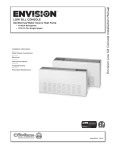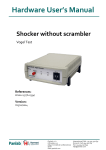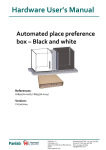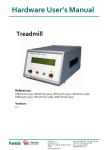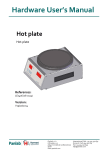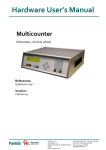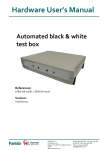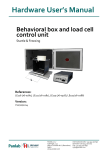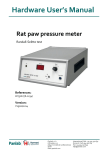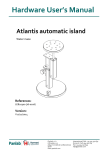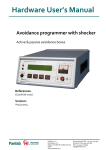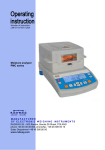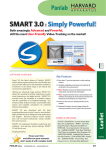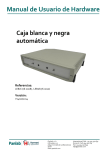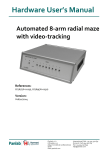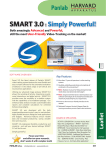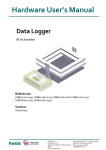Download Hardware User`s Manual 5
Transcript
Hardware User’s Manual 5-9 Holes box Operant conditioning References: LE507(76-0001), LE509(76-0000) Version: V23/10/2014 Panlab, s.l.u C/Energía, 112 08940 Cornellà de Ll.(Barcelona) Spain www.panlab.com International Calls: +34 934 750 697 Domestic Call: 934 190 709 Fax: +34 934 750 699 [email protected] Limitation of Liability PANLAB does not accept responsibility, under any circumstances, for any harm or damage caused directly or indirectly by the incorrect interpretation of what is expressed in the pages of this manual. Some symbols may have more than one interpretation by professionals unaccustomed to their usage. PANLAB reserves the right to modify, in part or in total, the contents of this document without notice. 1. SYMBOLS TABLE Recognising the symbols used in the manual will help to understand their meaning: DESCRIPTION SYMBOL Warning about operations that must not be done because they can damage the equipment Warning about operations that must be done, otherwise the user can be exposed to a hazard. Protection terminal ground connection. Warning about a hot surface which temperature may exceed 65ºC Warning about a metal surface that can supply electrical shock when it’s touched. Decontamination of equipments prior to disposal at the end of their operative life Waste Electrical and Electronic Equipment Directive (WEEE) 2. GOOD LABORATORY PRACTICE Check all units periodically and after periods of storage to ensure they are still fit for purpose. Investigate all failures which may indicate a need for service or repair. Good laboratory practice recommends that the unit be periodically serviced to ensure the unit is suitable for purpose. You must follow preventive maintenance instructions. In case equipment has to be serviced you can arrange this through your distributor. Prior to Inspection, Servicing, Repair or Return of Laboratory Equipment the unit must be cleaned and decontaminated. Decontamination prior to equipment disposal In use this product may have been in contact with bio hazardous materials and might therefore carry infectious material. Before disposal the unit and accessories should all be thoroughly decontaminated according to your local environmental safety laws. 5-9 holes box 2 3. UNPACKING AND EQUIPMENT INSTALATION WARNING: Failure to follow the instructions in this section may cause equipment faults or injury to the user. A. No special equipment is required for lifting but you should consult your local regulations for safe handling and lifting of the equipment. B. Inspect the instrument for any signs of damage caused during transit. If any damage is discovered, do not use the instrument and report the problem to your supplier. C. Ensure all transport locks are removed before use. The original packing has been especially designed to protect the instrument during transportation. It is therefore recommended to keep the original carton with its foam parts and accessories box for re-use in case of future shipments. Warranty claims are void if improper packing results in damage during transport. D. Place the equipment on a flat surface and leave at least 10 cm of free space between the rear panel of the device and the wall. Never place the equipment in zones with vibration or direct sunlight. E. Once the equipment is installed in the final place, the main power switch must be easily accessible. F. Only use power cords that have been supplied with the equipment. In case that you have to replace them, the spare ones must have the same specs that the original ones. G. Make sure that the AC voltage in the electrical network is the same as the voltage selected in the equipment. Never connect the equipment to a power outlet with voltage outside these limits. For electrical safety reasons you only can connect equipment to WARNING power outlets provided with earth connections . This equipment can be used in installations with category II overvoltage according to the General Safety Rules. The manufacturer accepts no responsibility for improper use of the equipment or the consequences of use other than that for which it has been designed. 5-9 holes box 3 PC Control Some of these instruments are designed to be controlled from a PC. To preserve the integrity of the equipment it is essential that the attached PC itself conforms to basic safety and EMC standards and is set up in accordance with the manufacturers’ instructions. If in doubt consult the information that came with your PC. In common with all computer operation the following safety precautions are advised. WARNING • To reduce the chance of eye strain, set up the PC display with the correct viewing position, free from glare and with appropriate brightness and contrast settings • To reduce the chance of physical strain, set up the PC display, keyboard and mouse with correct ergonomic positioning, according to your local safety guidelines. 5-9 holes box 4 4. MAINTENANCE WARNING: Failure to follow the instructions in this section may cause equipment fault. PRESS KEYS SOFTLY – Lightly pressing the keys is sufficient to activate them. Equipments do not require being disinfected, but cleaned for removing urine, faeces and odour. To do so, we recommend using a wet cloth or paper with soap (which has no strong odour). NEVER USE ABRASIVE PRODUCTS OR DISSOLVENTS. NEVER pour water or liquids on the equipment. Once you have finished using the equipment turn it off with the main switch. Clean and check the equipment so that it is in optimal condition for its next use. The user is only authorised to replace fuses with the specified type when necessary. OPENING FLANGE SWITCH FUSE-HOLDER Figure 1. Power inlet, main switch and fuse holder. FUSE REPLACEMENT In case of an over-voltage or other incident in the AC net making it impossible to turn on the equipment, check fuses according to the following procedure. 1 Remove power cord from the power inlet 5-9 holes box 5 2 Open fuse-holder by pulling the flange with a regular screwdriver Figure 2. Open fuse-holder door. 3 Extract fuse holder using the screwdriver. Figure 3. Extract fuse-holder. 4 Replace fuses if necessary. Insert fuses in the fuse-holder in the correct position. CORRECT INCORRECT Figure 4. Fuses position. 5 Insert again fuse-holder, both possible positions are correct because power supply is universal. 6 If the fuses blow again unplug the equipment and contact technical service. WARNING 5-9 holes box For electrical safety, never open the equipment. The power supply has dangerous voltages. 6 5. TABLE OF CONTENTS 1. SYMBOLS TABLE 2 2. GOOD LABORATORY PRACTICE 2 3. UNPACKING AND EQUIPMENT INSTALATION 3 4. MAINTENANCE 5 5. TABLE OF CONTENTS 7 6. INTRODUCTION 8 7. EQUIPMENT DESCRIPTION 9 7.1. CONTROL UNIT FRONT PANEL 9 7.2. CONTROL UNIT REAR PANEL 10 7.3. NINE-HOLES BOX 11 8. EQUIPMENT CONNECTIONS 13 9. WORKING WITH THE EQUIPMENT 15 9.1. CONDUNCTING A EXPERIMENT 15 9.2. CLEANING THE CAGE 9.2.1. CLEANING THE FLOOR AND TRAY 15 15 9.3. WALLS CLEANING 16 9.4. TRNASPARENT DOOR CLEANING 16 10. TROUBLESHOOTING 17 11. PREVENTIVE MAINTENANCE 18 12. SPECIFICATIONS 19 5-9 holes box 7 6. INTRODUCTION The nine-hole box is commonly used to evaluate attention performance in laboratory animals through a visual discrimination task. Figure 5. Nine-holes box schematic. The box is equipped with an arc of 9 contiguous apertures set into the rear wall, a house light, a food pellet dispenser and a magnetic detector to detect nose-pokes into the food holder. The holes not used in the experiment can be separately occluded using a metal insert. Each hole is equipped with photocell beams and a LED at the rear of the hole, providing visual cues specific to each hole. Different experimental paradigms can be conducted using the nine-hole box. For example, in the 5-choice serial reaction time task, short-lasting stimuli are given in pseudo-randomized order in one of the holes of the cage (commonly, holes 1, 3, 5, 7 or 9). If the animal nose-pokes into the correct hole, it is given a reinforcement (pellet). If the animal nose-pokes into an incorrect hole, it is given a time-out period (no light) and the next trial begins. The choice accuracy (% of correct responses) gives an idea of the functional integrity of the attention as well as learning processes. These parameters are usually altered in animal models of schizophrenia and Alzheimer’s disease. There are 2 cages LE507 is for mice and LE509 is for rats. 5-9 holes box 8 7. EQUIPMENT DESCRIPTION 7.1. CONTROL UNIT FRONT PANEL POWER START TELEPHONIC CONNECTORS LED Figure 6. Control Unit Front Panel. POWER: Red led that indicates that the control unit is ON. START: This button can be used to start the experiment (if the program requires it). The start button can also be used as a marker during the program. TELEPHONIC CONNECTORS: There are 3 telephonic connectors. o PELLETS: Used to connect the pellets dispenser. o LIGHT: Used to connect the light on the top of the box. o FEEDER: Used to connect the magnetic detector (to detect when the animal introduces its head to eat a pellet). LED: With this digital selector that goes from 1 to 9 it is possible to adjust the intensity of the light in the 9 holes (1 is the minimum and 9 is the maximum). 5-9 holes box 9 7.2. CONTROL UNIT REAR PANEL POWER REMOTE CAGE MAIN Figure 7. Control Unit Rear Panel. POWER: Power connector, main switch and fuse holder. CAGE: DB25 connector used to connect the control unit with the 9 holes. MAIN: DB9 female connector used to connect the control unit to the computer serial port, if the control unit is the first one. Alternatively, it is used to connect the control unit to the REMOTE port of the previous control unit, if the unit is not the first one. REMOTE: DB9 male connector used to connect the control unit to the MAIN port of the next control unit. If the control unit is the last one this port is kept free. 5-9 holes box 10 7.3. NINE-HOLES BOX PELLET DISPENSER PLATFORM FEEDER LIGHT TRAY 9 HOLES DOOR Figure 8. Nine-hole Box. PELLET DISPENSER: Supplies pellets to the animal as reinforcement. FEEDER: Detects when the animal introduces its head to eat a pellet. LIGHT: This light is placed on the top of the box. It is used as stimulus. PLATFORM: The box is placed on a stainless steel platform. TRAY: The tray is easily removable to clean animal excrements. 9 HOLES: There are 9 holes. Each hole has the following components: o LIGHT: The intensity of the light can be adjusted in the control unit using the digital selector labelled LED. o INFRARED EMITER: Emits an infrared beam, when the animal introduces its head into the hole the beam is cut and the system detects that the animal has introduced its head into the hole. 5-9 holes box 11 o INFRARED DETECTOR: Detects the infrared beam, when an animal cuts the beam the system detects that the animal introduces its head into the hole. 5-9 holes box 12 8. EQUIPMENT CONNECTIONS The LE507 - LE509 module is controlled by the PackWin computer program, through a serial port and the RS-232 protocol. Figure 9. Connection between module and computer with 1 cage system. The connections necessary for a one-cage system connection are listed in the following table: 1 2 3 4 5 5-9 holes box FROM Pellets Dispenser Light Pusher 9 holes PC serial port TO Control Unit 1 Control Unit 2 Control unit 3 CAGE connector MAIN connector CABLE Telephonic cable 1 Telephonic cable 2 Telephonic cable 3 DELTA 25 cable RS232 cable 13 A computer is able to control up to 10 modules at the same time, connecting them in a chain using the MAIN and REMOTE connections. Figure 10. Example of connection of 3 cages. Certain rules must be followed when connecting several modules in a series. All control units must have a different ID number. There is a decimal selector inside the control unit that allows selecting values between 0 and 9. The MAIN connector of the first control unit is connected to the computer serial port. The MAIN connector of each control unit is connected to the REMOTE port of the previous control unit. The REMOTE port of each control unit is connected to the MAIN port of the next control unit. The REMOTE port of the last control unit is left free. When several modules are connected in a chain, it is not necessary to connect them in the physical order of their identification numbers. WARNING: Do not confuse intensity light selector labelled LED with the ID selector that is hidden inside the box of the control unit. In order to change the ID number in the control unit of the cage you must unscrew the 4 screws on the four legs. Before opening control unit you must turn it off and unplug it from the mains. 5-9 holes box 14 9. WORKING WITH THE EQUIPMENT 9.1. CONDUNCTING A EXPERIMENT 1. Connect the equipment as explained in chapter 8. 2. If you will work with several cages at the same time you must set the ID numbers of all control units so that they are different. (See WARNING at the end of chapter 8). 3. Turn all control units on. 4. Turn on the PC. 5. Once the PC is booted, run the program PackWin. 6. Open a new protocol or edit an existing one in PackWin. (Read the user manual of this program for more information). 7. Place the subject in the experimental cage. 8. Begin the experiment. 9. Once the experiment is finished remove the subject from the experimental cage. 10. Turn off all control units and the PC. 11. Clean the cage to left it in good conditions for the next experiment. 9.2. CLEANING THE CAGE 9.2.1. CLEANING THE FLOOR AND TRAY The floor of the cage is made of metal with holes so that faeces and urine fall into the tray. The tray contains the metal floor and collects faeces and urine. The set formed by floor and tray can be removed from the cage to be cleaned. Once removed from the cage for cleaning you can use soap and water, then dry them well before replacing them back into the cage. 5-9 holes box 15 9.3. WALLS CLEANING To clean the walls you can use a slightly wet cloth and then dry them with a dry cloth. If they’re too dirty you can wet the cloth with a soapy solution to clean them, then remove the foam with a wet cloth and finally dry them with a dry cloth. 9.4. TRNASPARENT DOOR CLEANING WARNING: In order to clean transparent door never use neither alcohol nor alcoholic derived products, otherwise stripes will appear in the transparent plastic. To clean the door you can use a lightly wet cloth and then dry it with a dry cloth. If it’s too dirty you can wet the cloth with a soapy solution, then remove foam with a wet cloth and finally dry it with a dry cloth. 5-9 holes box 16 10. TROUBLESHOOTING This table features instructions to solve the most frequent problems. PROBLEM SOLUTION Check the condition of the fuses. The equipment does not start up. The equipment is not identified by the program PackWin. Check that the phone cord that connects the control unit to the pellets dispenser is plugged into the correct port labelled "Pellet" (see Figure 9). Check that the phone cord that connects the control unit with the light is connected in the correct port labelled "Light" (see Figure 9). Check that the phone cord that connects the control unit with the door of the feeder is connected to the correct port labelled "Feeder" (see Figure 9). Check that the DB25 flat cable is connected between the control unit and the experimental cage (see Figure 9). Check that the DB25 flat cable is connected between the control unit and the experimental cage (see Figure 9) The pellets dispenser does not work. The light of the cage does not work. The door of the feeder, does not detect when the animal enters the head to eat. The equipment does not detect when the animal enters the nose in one of the holes with light. The lights do not come on nine holes. 5-9 holes box Check that the RS232 cable is connected between the control unit and the serial port of the PC (see Figure 9). When working with several control units connected in series, check the connections MAIN-REMOTE (see Figure 10) If you work with several control units all of them must be turned on in order no cut MAIN -REMOTE communications. If you work with multiple control units, all ID numbers must be different so that the PC is able to differentiate them. If you use a USB to RS-232 check for proper setup on the PC. 17 11. PREVENTIVE MAINTENANCE EXPERIMENT MONTHLY FLOOR CLEANING TRAY CLEANING TRANSPARENT DOOR CLEANING WALLS CLEANING CHECK FLOOR AND TRAY PLACING 5-9 holes box 18 12. SPECIFICATIONS POWER SUPPLY Input voltage: Frequency: Fuse: Maximum power: Conducted noise: Universal 100-240V ~ 50/60 Hz 2 fuses 5mm*20mm 2A 250V Fast 30W EN55022 /CISPR22/CISPR16 class B ENVIRONMENTAL CONDITIONS Operating temperature: Operating relative humidity: Storage temperature: 10°C to +40°C 0% to 85% RH, non-condensing 0°C to +50°C, non-condensing FRONT PANEL PORTS Connector Ports: LIGHT PELLETS FEEDER RJ12 BULB Voltage: Power: 24V 0,1W COMUNICATIONS OUTPUT Standard interface: Connector: RS232C Delta 9-contact connector DIMENSIONS (control unit) Width x Height x Depth: Weight: 150 mm*66 mm*250 mm 1.41 kg DIMENSIONS (cage LE 507) Width x Height x Depth: Weight: 442 mm*350 mm*365 mm 6,43kg DIMENSIONS (cage LE 509) Width x Height x Depth: Weight: 442 mm*350 mm*365 mm 7,36kg 5-9 holes box 19 DECLARACIÓN DE CONFORMIDAD DECLARATION OF CONFORMITY DECLARATION DE CONFORMITÉ Nombre del fabricante: Manufacturer’s name: Nom du fabricant: Panlab s.l.u. www.panlab.com [email protected] Dirección del fabricante: Manufacturer’s address: Adresse du fabricant: Energía, 112 08940 Cornellà de Llobregat Barcelona SPAIN Declara bajo su responsabilidad que el producto: Declares under his responsibility that the product: Déclare sous sa responsabilité que le produit: NINE HOLE BOX Marca / Brand / Marque: PANLAB Modelo / Model / Modèle: LE 507 – LE 509 Cumple los requisitos esenciales establecidos por la Unión Europea en las directivas siguientes: Fulfils the essential requirements established by The European Union in the following directives: Remplit les exigences essentielles établies pour l’Union Européenne selon les directives suivantes: 2006/95/EC 2004/108/EC 2012/19/EU 2011/65/EU 2006/42/EC Directiva de baja tensión / Low Voltage / Basse tensión Directiva EMC / EMC Directive / Directive CEM La Directiva de Residuos de Aparatos Eléctricos y Electrónicos (WEEE) / The Waste Electrical and Electronic Equipment Directive (WEEE) / Les déchets d'équipements électriques et électroniques (WEEE) Restricción de ciertas Sustancias Peligrosas en aparatos eléctricos y electrónicos (ROHS) / Restriction of the use of certain Hazardous Substances in electrical and electronic equipment (ROHS) / Restriction de l'utilisation de certaines substances dangereuses dans les équipements électriques et électroniques (ROHS) Directiva mecánica / Machinery directive / Directive mécanique Para su evaluación se han aplicado las normas armonizadas siguientes: For its evaluation, the following harmonized standards were applied: Pour son évaluation, nous avons appliqué les normes harmonisées suivantes: Seguridad / Safety / Sécurité: EMC: Safety of machinery: EN61010-1:2010 EN61326-1:2013 Class B EN ISO 12100:2010 En consecuencia, este producto puede incorporar el marcado CE: Consequently, this product can incorporate the CE marking: En conséquence, ce produit peut incorporer le marquage CE: En representación del fabricante: Manufacturer’s representative: En représentation du fabricant: Carme Canalís General Manager Panlab s.l.u., a division of Harvard BioScience Cornellà de Llobregat, Spain 25/06/2014 5-9 holes box 20 5-9 holes box 21






















